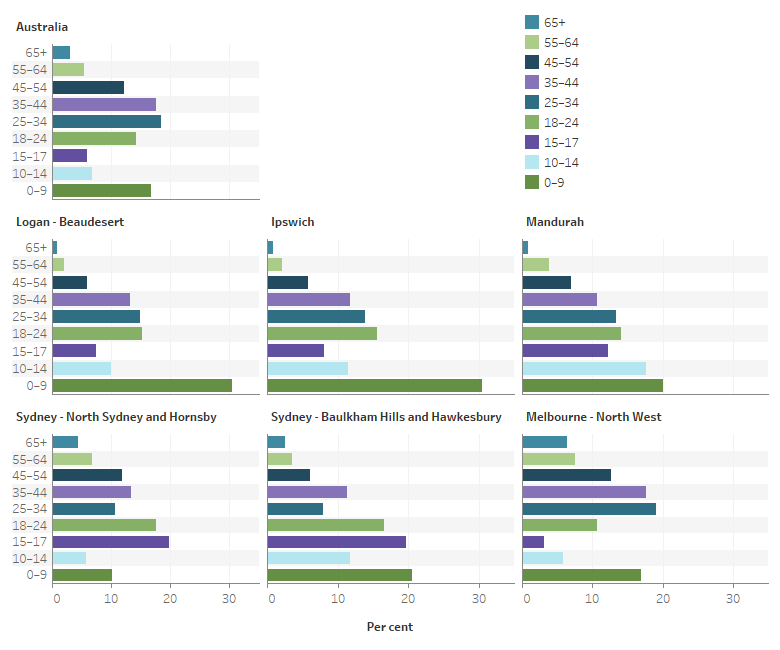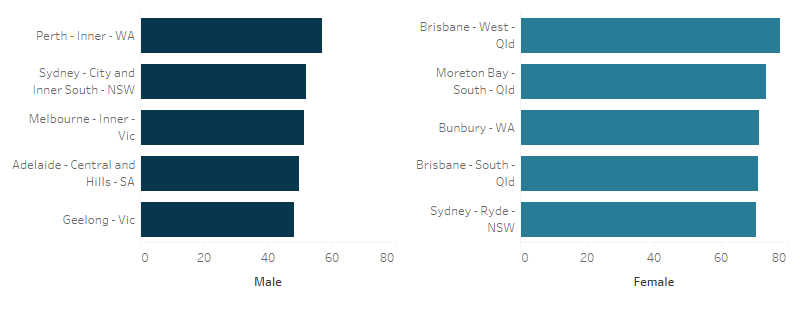Client geography
The rate at which people access Specialist Homelessness Services (SHS) can vary geographically due to different demographics, varying service accessibility and availability and region-specific factors such as housing availability and affordability. It is important to note that the rate of SHS clients is a measure of service response and does not necessarily reflect the local level of people in unstable housing situations.
In Australia, market changes can influence the availability of housing options within an area (Wood et al. 2014). Although the rate of homelessness is higher in remote areas, it is increasingly more common in areas with decreasing availability of affordable private renting and increasing overcrowding, such as major cities (Parkinson et al. 2019).
This section provides an overview of the geography of clients supported by SHS clients across Australia based on the client’s location prior to receiving SHS support.
Key findings
- The highest rate of clients were in Western Australia – Outback (North) (583.1 clients per 10,000 or 5,700 clients) and the Northern Territory – Outback (575.9 clients per 10,000 population or 5,700 clients).
- The lowest rate of clients were around Sydney (Ryde 14.3 clients per 10,000, Baulkham Hill and Hawkesbury 15.5 per 10,000) and Brisbane – West (15.8 clients per 10,000).
Identifying client location in the Specialist Homelessness Services Collection (SHSC)
This section examines people seeking SHS support based on where the person lived in the week before presenting to a SHS agency, as reported at the first support period during 2019–20. Clients are assigned to only one region for the financial year but may move to other regions before subsequent support periods. This location may not be a permanent address, for example, people who were couch surfing the week prior to seeking services may nominate the location of their temporary accommodation. Client location is classified to Statistical Area 4 (SA4) based on the 2016 Australian Statistical Geography Standard (ASGS) (ABS 2016). A total of 88 SA4s are reported in this section, which excludes non-geographic codes and Other Territories. Please note that other geographic analysis in the report is based on agency location. See Technical information for more details.
Geographic profile of SHS clients
In 2019–20, SHS agencies assisted nearly 290,500 clients across Australia, up from 290,300 in 2018–19. The rate of people receiving SHS services varied by region in 2019–20 (Supplementary table CLIENTLOC.1):
- The highest rate of SHS clients were in Western Australia – Outback (North) (583.1 per 10,000 population), higher than the West Australian and national rates (95 and 114.5 respectively).
- The highest number of clients was in Melbourne – West (Victoria) (16,000 clients or 189.5 per 10,000 population).
|
State |
SA4 |
Client rate (per |
Client |
||||
|---|---|---|---|---|---|---|---|
|
Highest (rate per 10,000 ERP) |
|||||||
|
Western Australia |
Western Australia – Outback (North) |
583.1 |
5,712 |
||||
|
Northern Territory |
Northern Territory – Outback |
575.9 |
5,683 |
||||
|
Victoria |
North West |
303.3 |
4.614 |
||||
|
Victoria |
Latrobe-Gippsland |
270.0 |
7,748 |
||||
|
Victoria |
Shepparton |
267.3 |
3,586 |
||||
|
Lowest (rate per 10,000 ERP) |
|||||||
|
Queensland |
Moreton Bay-South |
22.6 |
495 |
||||
|
New South Wales |
Sydney - North Sydney and Hornsby |
18.0 |
796 |
||||
|
Queensland |
Brisbane - West |
15.8 |
306 |
||||
|
New South Wales |
Sydney - Baulkham Hills and Hawkesbury |
15.5 |
391 |
||||
|
New South Wales |
Sydney - Ryde |
14.3 |
292 |
||||
Notes:
- Client location based on location the week before first presentation, as reported at the first support period to an SHS agency in 2019–20.
- Rates are crude rates based on the Australian estimated resident population (ERP) at 30 June of the reference year.
Source: Specialist Homelessness Services Collection 2019–20, Supplementary table CLIENTLOC.1.
Housing situation
Among clients whose housing status was known at the beginning of their first support period in 2019–20, around 113,700 clients presented homeless and 152,300 presented at risk of homelessness to SHS agencies across Australia (Supplementary table CLIENTS.11).
The proportion of homeless and at risk clients varied by geographic region:
- Clients presenting at risk of homelessness to an SHS agency made up the majority (more than 50% of clients where housing situation known) of clients in 60 SA4 regions while clients presenting homeless made up the majority in the remaining 28 SA4s.
- The highest proportion of homeless clients was in Perth - Inner (74% or 1,100 clients) in Western Australia’s capital region while the highest proportion of at risk clients were in Melbourne – Inner East (74% or 2,200 clients).
The age of clients seeking SHS assistance varied by geography across Australia in 2019–20 (Figure CLIENTLOC.1):
- The greatest proportion of child clients (aged 0 to 9 years) occurred in Logan - Beaudesert (31% of clients) and Ipswich in Queensland (30% of clients).
- The greatest proportion of young people (aged 15 to 24 years) occurred in Sydney – North Sydney and Hornsby (37% of clients) and Sydney – Baulkham Hills and Hawkesbury (36% of clients).
- The greatest proportion of older clients (65 years and over) occurred in Melbourne – North West (6% of clients)
Figure CLIENTLOC.1: Proportion of clients seeking services, by age group, by selected Statistical Area 4 (SA4) regions, 2019–20

Note: Clients are assigned to a region based on where they lived in the week before presenting to a SHS agency in 2019–20. Clients are assigned to one region, based on the location details provided in the first support period in the reference year. Regions are defined by the 2016 Australian Statistical Geography Standard (ASGS).
Source: Specialist Homelessness Services Collection 2019–20, Supplementary table CLIENTS.1 and CLIENTLOC.1.
Of the 290,500 clients presenting to SHS agencies across Australia, females made up the majority of clients in 2019–20 (60% or around 174,700 clients: Supplementary table CLIENTS.1). The location of male and female clients the week before presenting to a SHS agency varied (Figure CLIENTLOC.2):
- The highest proportion of female clients receiving services were in Brisbane – West and Moreton Bay - South (Queensland); 78% and 74% respectively.
- Male clients made up the majority of clients in more urban areas of state capital cities with the highest proportion of males in Perth - Inner (57%).
Figure CLIENTLOC.2: Proportion of clients receiving SHS services, by sex, by Statistical Area 4 (SA4), 2019–20

Notes:
- Per cent calculations based on total clients excluding clients from 'Other territories' and those that have not provided address information. Proportions may not add to 100% due to rounding
- Clients are assigned to a region based on where they lived in the week before presenting to a SHS agency in 2019–20. Clients are assigned to one region, based on the location details provided in the first support period in the reference year. Regions are defined by the 2016 Australian Statistical Geography Standard (ASGS).
- Mapped SA4s (88) exclude Other Territories and non-geographic SA4s coded as No usual address, Migratory, Offshore or Shipping.
Source: Specialist Homelessness Services Collection 2019–20, Supplementary table CLIENTLOC.1.
References
ABS (Australian Bureau of Statistics) 2016. Australian Statistical Geography Standard (ASGS): Volume 1—Main Structure and Greater Capital City Statistical Areas, July 2016. ABS cat. no. 1270.0.55.001. Canberra: ABS.
Parkinson S, Batterham D, Reynolds M & Wood G 2019. The changing geography of homelessness: a spatial analysis from 2001 to 2016, AHURI Final Report 313. Melbourne: Australian Housing and Urban Research Institute.
Wood G, Batterham D, Cigdem M & Mallett S 2014. The spatial dynamics of homelessness in Australia 2001–11, AHURI Final Report No.227. Melbourne: Australian Housing and Urban Research Institute.


